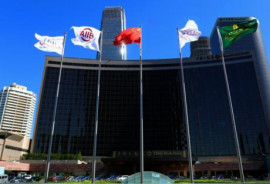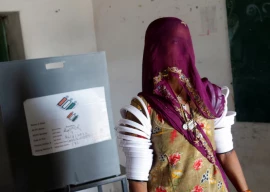
The gap is in the range of $11 billion to $12 billion, said Bajwa after attending a meeting of the National Assembly Standing Committee on Finance and Revenue. The central bank governor gave an in-camera briefing to the parliamentary body on the reasons behind the weakening rupee and the “grave challenges” to the economy in the months ahead.
The decision to hold the meeting without the presence of media was taken suddenly, as the finance ministry and the SBP did not want to share the negative news on the external front with the public.
ADB lauds Pakistan's efforts in overcoming energy deficit
The governor also did not share with the media the source of funds for the huge $12-billion financing gap if Pakistan wants to ensure gross official foreign currency reserves do not fall below $14.6 billion. He also ruled out the possibility of floating another sovereign bond in the coming months.
Chances are that the gap will be filled by using official foreign currency reserves as well as resorting to more short- and long-term borrowings including from foreign commercial banks.
Pakistan’s gross external financing requirements are roughly $20 billion, which includes an estimated $14-billion current account deficit and another $5.9-billion foreign debt repayment component during the current fiscal year. Of the $20 billion, the government has around $9 billion, which leaves net financing gap of about $11-12 billion
After the conclusion of the recently-held Post Programme Monitoring talks, the International Monetary Fund (IMF) had said that Pakistan’s external sector would continue to remain under pressure. Former finance minister Dr Hafiz Pasha last week forewarned that the country was in an incipient financial crisis that will remain for a longer period.
The statement about the quantum of the external financing gap comes amid another disclosure that the government’s external debt related obligations in the current fiscal year will be $5.9 billion - higher by 38% over the finance ministry’s earlier estimates. In response to a question, Finance Secretary Shahid Mahmood informed the standing committee that during the current fiscal year the government’s external debt obligations are $5.9 billion.
The figure is $1.64 billion or 38% higher than the projections that the finance ministry had earlier shared with the National Assembly in writing. This shows that either the finance ministry concealed the real facts from parliament or it did not know exactly the quantum of external debt obligations.
The finance secretary said that out of $5.9 billion, the government has already paid $2.4 billion on account of principal and interest on these loans. He said that remaining $3.5 billion will be paid in the coming seven months.
While responding to a question on exchange rate, Bajwa said that since July this year, the rupee has cumulatively shed its value by over 7.22% including 5% in the recent past. The SBP governor did not comment on the future course of the rupee.
To a question whether the SBP was immediately in a position to return $6.16 billion that it has borrowed from the commercial banks for the short term, the governor said that the SBP can return these loans. But he did not answer what was the reason to take the $6-billion loans from commercial banks.
UK gives $50 million to AIIB
Pasha said that excluding the over $6 billion in loans that the SBP took from commercial banks, the central bank’s net reserves will fall to $3 billion by June 2018. But the SBP governor said that Pasha’s estimates were “very conservative” and the SBP will perform better than this.
As of November this year, the central bank borrowed $6.16 billion from commercial banks under the forward and currency swap arrangements, according to SBP data. This amount is also shown part of both the central bank and commercial bank’s reserves, as also admitted by Dr Miftah Ismail, Special Assistant to Prime Minister on Economic Affairs in a TV programme.
As of December 8, 2017, the SBP’s official foreign currency reserves were $14.66 billion including $6.16 billion worth of currency swaps and forward contracts. In 1998, the then PML-N government had consumed foreign currency deposits of commercial banks after global powers imposed sanctions on Pakistan in retaliation to nuclear tests.
Published in The Express Tribune, December 20th, 2017.
Like Business on Facebook, follow @TribuneBiz on Twitter to stay informed and join in the conversation.




















-(1)1714116455-0/Heeramandireactions-(2)-(1)1714116455-0-270x192.webp)












1714024018-0/ModiLara-(1)1714024018-0-270x192.webp)









COMMENTS (2)
Comments are moderated and generally will be posted if they are on-topic and not abusive.
For more information, please see our Comments FAQ